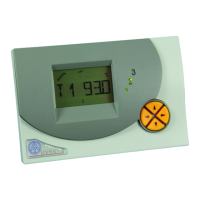105
DIF Temporary temperature difference between the flow and return sensor (Maximum
display ±8.5 K, above an arrow is displayed). If both sensors are immersed in one
bath for test reasons (with both thus measuring the same temperatures), the
device should display “
DIF 0”. Sensor and measurement equipment tolerance
may, however, lead to a displayed difference under
DIF. If this display is set to
zero, the computer saves the difference as a correction factor and then calculates
the heat amount adjusted by the natural measurement error.
This menu item
thus provides a way to calibrate to system. The display may only be set to
zero (i.e. changed) if both sensors have the same measurement conditions
(same bath). In addition, the temperature of the test medium should be around
50-60°C.
HQC CL Clear heat quantity counter. The cumulative amount of heat can be reset with the
key (=enter).
If the amount of heat is zero, CLEAR is displayed in this menu item.
If the heat counter has been activated, the following are displayed in the basic menu:
the current output in kW
the amount of heat in MWh and kWh
of the volume flow in litres/hour
NOTICE: If an error (short circuit, interruption) occurs at one of the two set sensors (supply
sensor, return sensor) for the heat counter, the current output is set at 0, i.e. no
heat is counted.
NOTICE: As the internal storage (EEPROM) has only a limited number of write cycles, the
totalled heat quantity is saved only once per hour. For this reason, it is possible
that a power failure can result in loss of the heat-quantity data for one hour.
Tips on accuracy:
A heat counter can only be as exact as its sensors and equipment. In the range from 10°C
to 90°C the standard solar control sensors (PT1000) have an accuracy of approximately +/-
0.5K. For KTY sensors the equivalent figure is +/- 1K. The unit’s measurement equipment is
accurate down to +/- 0.5K according to laboratory measurements. PT1000 sensors may be
more accurate, but they have a weaker signal that increases the error. In addition, the proper
installation of the sensors is crucial and can increase error considerably if installed
improperly.
If all of the tolerances cumulate in a worst-case scenario, the error would be 40% (KTY) at
a typical temperature difference of 10 K! However, normally the error should be below 10%
as the equipment error affects all of the input channels the same and the sensors are from
the same production batch. The tolerances thus cancel each other out somewhat. In general:
the greater the differential temperature, the smaller the error. The measurement results
should always been seen just as guide values in all respects. The adjustment due to
measurement differences (see
DIF:) leads to a measurement error in standard applications
of around 5%.

